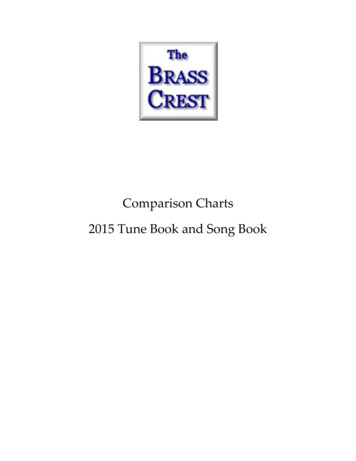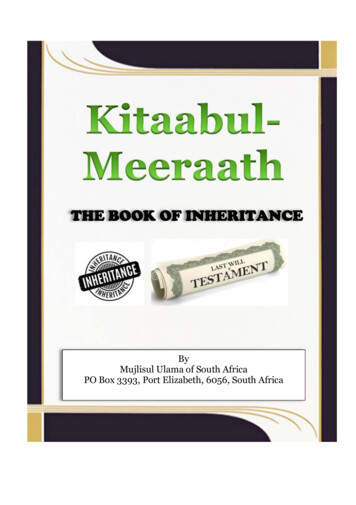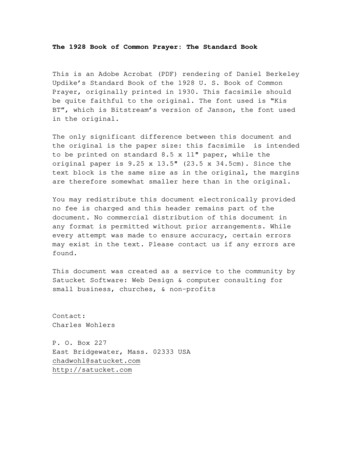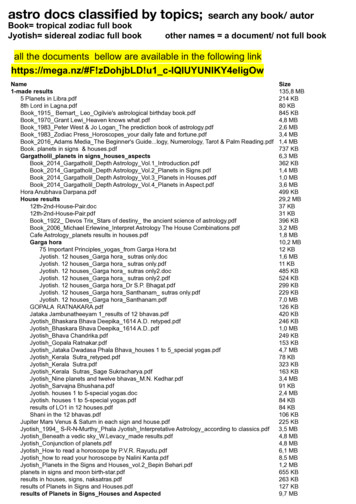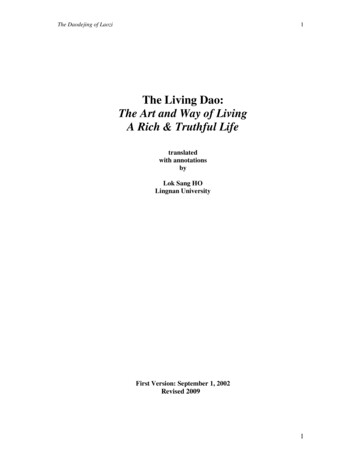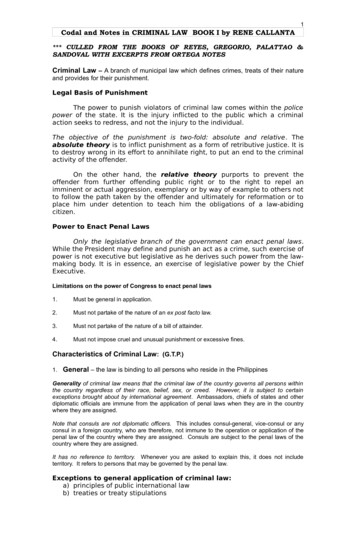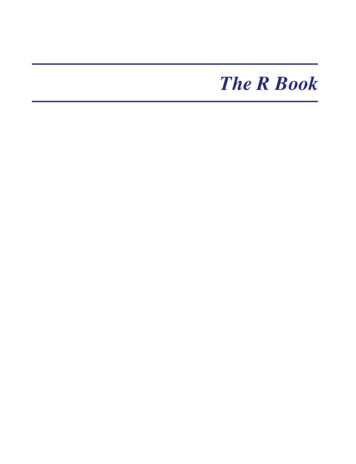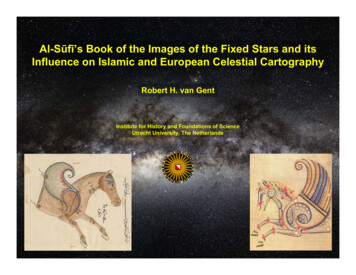
Transcription
Al-Sūfī’s Book of the Images of the Fixed Stars and itsInfluence on Islamic and European Celestial CartographyRobert H. van GentInstitute for History and Foundations of ScienceUtrecht University, The Netherlands
Biographical Sketch of al-SūfīAbū al-Husayn ‘Abd al-Rahmān ibn ‘Umaral-Sūfī was born in Rayy (near Tehrān) on7 December 903 [14 Muharram 291 AH] anddied in Baghdād on 25 May 986[13 Muharram 376 AH].Al-Sūfī wrote on astrology, astronomy,alchemy and mathematics.His best-known work is the Kitāb Suwar alKawākib al-Thābitah (“Book of the Imagesof the Fixed Stars”) which he completed inShīrāz around 964.Originally written in Arabic, it was latertranslated into Persian and also into Latin.He also wrote a comprehensive treatise onthe astrolabe in 1760 chapters which onlysurvives in a shortened version in 170chapters.The lunar crater Azophi and the minorplanet 12621 Alsufi commemorate hisachievements in astronomy.Detail from Albrecht Durer’s woodcut map Imagines coeliSeptentrionales cum duodecim imaginibus zodiaci (1515)
The Star Catalogue of ClaudiusPtolemy of Alexandria (c. 150 CE)Almagest, books VII & VIIIContains 1028 stars, of which three are duplicateentries, divided into 48 separate constellations. Fivestars are listed as ‘nebulous’ and six stars arelisted as ‘reddish’. Adopts the magnitude scale ofHipparchus of Nicaea (c. 130 BCE)Ecliptic coordinate systemMean deviation in latitude:Mean deviation in longitude:Systematic deviation in longitude:0.3 0.3 1.0 Epoch: 1 Thoth, 885 Nabonassar [ 20 July 137 CE]Ptolemy assumed a constant rate of precessionamounting to 1.0 per centuryOil on poplar panel attributed to Joos van Wassenhove(c. 1475) for the studiolo of Federico II da Montefeltro inthe Ducal Palace of Urbino (now in the Louvre, Paris)
The 48 Constellations of Claudius PtolemyNorth of the 18.19.20.21.Ursa MinorUrsa MajorDracoCepheusBootesCorona phiuchusSerpensSagittaAquila ( umZodiacal AriesTaurusGeminiCancerLeo ( Coma AquariusPiscesSouth of the 48.CetusOrionEridanusLepusCanis MajorCanis MinorArgo NavisHydraCraterCorvusCentaurusLupusAraCorona AustralisPiscis Austrinus
The Star Atlas of al-SūfīThe work was dedicated to the Buyid ruler Abū Shujā‘ Fannā Khusraw, entitled ‘Adud al-Dawla (936983), who was a friend and a pupil of al-Sūfī and whose court was seated at Shīrāz (until 977/78) andBaghdādEpoch star catalogue: 1276 Alexander [1 October 964] Almagest longitudes 12 42'Al-Sūfī adopted a precession constant of 1 in 66 yearsFor many stars al-Sūfī provided improved magnitude estimates and for a few notable stars he notedits colourEight Ptolemaic stars could not be identified by al-Sūfī and were omitted from the catalogue: the 14th star of Auriga the 11th star of Lupus the six ‘unformed’ stars of Piscis AustrinusEach constellation description was augmented by a mirrored pair of star maps, as viewed in the skyand as viewed on a celestial globeIn addition, al-Sūfī added information on pre-Islamic sky lore and many additional stars, not listed inPtolemy’s Almagest, including: nebulous star above the 14th star of Andromeda [ Andromeda Spiral Nebula] a small cloud in Aquila Brocchi’s Cluster, Collinder 399 or the Coat Hanger nebulous star above the 37th star of Argo Navis Omicron Velorum Cluster [IC 2391]In some of the manuscripts the additional stars are also plotted in another colour
Known Manuscripts of al-Sūfī’s Star AtlasArabic text10 Istanbul8 Paris6 Tehran5 London4 Berlin, Cairo3 Oxford, Princeton, St. Petersburg2 Copenhagen, Dublin, Mosul, Tunis1 Bologna, Doha, Escorial, Geneva, Hyderabad, Leiden, New York,Rampur, Strasbourg, Uppsala, Vatican City, WashingtonPersian translation3 Paris2 Cairo, Dublin, New York1 Berlin, Istanbul, Kuwait, Mashhad, Tehran
The Bodleian Manuscript (Marsh 144)Colophon of the Bodleian manuscript Marsh 144 ofal-Sūfī’s star atlas, acquired in 1641 in Istanbul byChristian Ravius (1613-1677) who had the missingpages (first eleven folios) replacedDated 400 AH [1009/10 CE] and copied byal-Sūfī’s sonLater owners of this unique manuscript were JacobGolius (1596-1667) and Narcissus Marsh (1638-1713)
The constellations Ursa Minor and Pegasus in the Bodleian manuscript(from the facsimile published in 1986 by Fuat Sezgin)
The constellation Andromeda in the Bodleian manuscript
The constellation Andromeda with the Andromeda Spiral Nebula (Messier 31 NGC 224)Not mentioned in Ptolemy’s Almagest
The constellations Cetus and Orion in the Bodleian manuscript
The Paris Manuscript(BNF Arabe 5036)Copied around 1430-40 in Samarkand, fromthe library of Ulugh BegNoteworthy are Far-Eastern influences inthe depiction of several constellations(Draco, Cetus, Hydra)The complete manuscript is online at theGALLICA websiteThe constellationsCentaurus and Lupus
The constellation Ursa Minor (star map and star table) in the Paris manuscript
The constellations Hydra, Crater and Corvus in the Paris manuscript
The Doha ManuscriptIn 1998 an hitherto unknown early copyof al-Sūfī’s star atlas, dated 519 AH[1125 CE], was auctioned in London bySotheby’sIt was acquired by Sheikh Saud al-Thaniof Qatar and is currently on display inthe Museum of Islamic Art in DohaA detailed description of the manuscriptby David A. King, Barbara Brend andRobert Hillenbrand is included in theSotheby’s auction catalogue
The constellation Pegasus in the Doha manuscript
The constellation Andromeda in the Doha manuscript
Some Pre-Islamic Constellations Depicted in al-Sūfī’s star atlasThe HorseOxford, Bodleian LibraryMarsh 144 [1009/10 CE]Paris, Bibliothèque NationaleArabe 5036 [c. 1430/40 CE]Princeton University LibraryGarrett 2259 Y [1607 CE]
Cassiopeia and the CamelOxford, Bodleian Hunt 212 [1171 CE]Andromeda, the Horse and the CamelDoha, Museum of Islamic Art [1125 CE]
The Pre-Islamic Constellation al-ThurayyaNew York Public Library, ms. Spencer Pers. 6 [1630/33 CE]Roland Laffitte, Des noms arabespour les étoiles (2001)
Transmission to Islamic Scientific WorksAl-Sūfī’s star atlas is named in the works of the following Islamic scholars:Abū Rayhān al-Bīrūnī (973-1048 CE) Kitāb al-Āthār al-Bāqiyya [“Chronology of Ancient Nations”] Kitāb al-Tafhīm li-Awā’il sinā‛at al-Tanjīm [“Instruction in the Elements of the Art of Astrology”]Abū Yahyā Zakariyyā ibn Muhammad ibn Mahmūd al-Qazwīnī (c. 1203 – 1283 CE) Kitāb ‛Ajāib al-Makhlūqat wa Gharāib wa al-Mawjūdāt [“Marvels of Creatures and Rarities of the World”]Shihāb al-Dīn Ahmad ibn Mājid ibn Muhammad al-Sa‛dī (15/16th cent. CE) Kitāb al-Fawā’id fī Ma‛rifad ‛ilm al-Bahr wa’l -Qawā’id [“Uses and Knowledge of Sea Science and Rules”]
Islamic Celestial GlobesThe information from al-Sūfī’s staratlas was commonly employed byIslamic instrument makers for theconstruction of celestial globes,thus continuing a tradition thatappears to have originated inHarrānAl-Sūfī also made celestial globesand a particularly fine celestialglobe made of silver was seen in435 AH [1043/44 CE] in the publiclibrary of Cairo by the Egyptianastrolabe maker Ibn al-SinbadīIslamic celestial globe, dated 764 AH [1362/63 CE](Oxford, Museum of the History of Science)
Islamic celestial globe, dated 674 AH [1275/76 CE] (London, British Museum)
Persian Translations of al-Sūfī’sStar AtlasThe earliest-known Persian translation of alSūfī’s star atlas was made in 647 AH [1250 CE]by Nasīr al-Dīn al-Tūsī (1201-1274).The constellation Perseus in a Persian translationof al-Sūfī’s star atlas, dated 1043 AH [1633/34 CE],in the National Library of EgyptLater Persian translations were made byLutfallah Muhandis ibn Ahmad al-Nadir alMi‘mar al-Lahūrī (late 16th cent.) and by Hasanibn Sa‘d al-Qā’īnī (early 17th cent.), the latterfor Abū’l-Fath Manūchihr Khān, governorgeneral of Mashhad.
The Star Catalogue of Ulugh BegThe star catalogue in al-Sūfī’s work was revisedby astronomers employed by the Uzbek ruler andastronomer Ulugh Beg (1393-1449), the grandsonof Tamerlane.The stellar coordinates in the Zīj-i Jadīd-i Sultānīwere adjusted to the epoch 1 Muharram 841 AH[4 July 1437 CE].27 stars, too far south to be observed from UlughBeg’s observatory in Samarkand, were copiedfrom al-Sūfī’s star atlas.
The Latin Translation of al-Sūfī’sStar AtlasFirst translated into Latin in the 13th century,probably in SicilyNine manuscripts are know known, later copiesoften featuring a star table adjusted to theepoch 1428For each constellation, only one image is givenMajor source for Arabic star names in laterEuropean star listsThe constellation Perseus (Gotha,Forschungs-bibliothek M II 141)
The Constellation Draco in the Sūfī-Latinus TraditionPrague, Památník Národního PísemnictvíStrahoviensis D.A. II. 13Gotha, ForschungsbibliothekM II 141Munich, Bayerische StaatsbibliothekClm 826
The constellation Andromeda in the Latin version of al-Sūfī’s star atlas (Gotha, Forschungsbibliothek) and inIsmael Boulliau’s Ad astronomos monita duo (1667), copied from an anonymous manuscript dated 1428
The Libros del saber de astrologíaA Castilian translation of al-Sūfī’s star atlas wasprepared in 1256 by Judah ben Moses ha-Cohenwith the assistance of Guillén Arremón DaspaIt was revised in 1276 by Alfonso X el Sabio, kingof Castile and León, and several scholars and wasincluded as the Libro de las estrellas de la ochavaespera in the Libros del saber de astrologíaEpoch set to 1 January 1252 by adding 17 08' toPtolemy’s longitudes [ al-Sūfī’s epoch 4 26']The star table in the Parisian Alfonsine Tables(with nearly identical epoch) was based on Gerardof Cremona’s translation of the Almagest (c. 1175)Armillary sphere from the Libros del saber de astrología(Madrid, Universidad Complutense ms 156, c. 1276)
The constellations Eridanus and Corona Australis in the Libro de las estrellasde la ochava espera (Madrid, Universidad Complutense ms 156, c. 1276)
Al-Sūfī and Petrus ApianusIn 1533 Petrus Apianus (1495-1552)from Ingolstadt published a star map inhis Horoscopion generale (and also inhis Instrument Buch of 1533) whichcontained several ‘Arabic’ asterismsapparently based on an Arabic copy ofal-Sūfī’s star atlas in his possessionIn 1532 Petrus Apianus received animperial printing privilege to publishseveral books, including a LiberAzophi Astrologi vetustissimi, but forreasons unknown no such book wasever publishedIn the chapter on constellations andstar names in his AstronomicumCaesareum (1540) Petrus Apianus onseveral occasions referred to a workby ‘Azophi Arab[u]s’ for traditionalArabic star namesPetrus Apianus, Horoscopion generale (1533)
Celestial Globe by Jacob AertszColom & Jacob GoliusAl-Sūfī’s stellar nomenclature was also adoptedon the 34-cm celestial globe published in the1640s in Amsterdam by Jacob Aertsz Colom(1599-1673) in collaboration with the Leidenoriental scholar and astronomer Jacob Golius(1596-1667)
Recent Publications on Islamic Star Names
Recent Art-Historical Studies of al-Sūfī’s Star Atlas
Schjellerup Edition (1874)Edition of the complete text with aFrench translation by Hans KarlFrederik Kristian Schjellerup (18271887), based on a manuscript inCopenhagen, dated 1010 AH [1602 CE],and a manuscript in St. Petersburg,dated 1015 AH [1606 CE]
May 2010: English translation of al-Sūfī’s staratlas announced by Ihsan Hafez, a Lebaneseastronomer and international student at theJames Cook University (Australia)
Almagest, books VII & VIII Contains 1028 stars, of which three are duplicate entries, divided into 48 separate constellations. Five stars are listed as ‘nebulous’ and six stars are listed as ‘reddish’. Adopts the magnitude scale of Hipparchus of Nicaea (c. 130 BCE) Ecliptic coordinate system Mean deviation in latitude: 0.3 Mean deviation in longitude: 0.3 Systematic deviation in .
